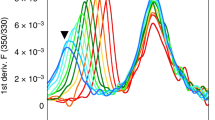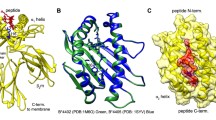Abstract
Binding between major histocompatibility complex (MHC) class I molecules and immunogenic epitopes is one of the most important processes for cell-mediated immunity. Consequently, computational prediction of amino acid sequences of MHC class I binding peptides from a given sequence may lead to important biomedical advances. In this study, an efficient structure-based method for predicting peptide binding to MHC class I molecules was developed, in which the binding free energy of the peptide was evaluated by two individual docking simulations. An original penalty function and restriction of degrees of freedom were determined by analysis of 361 published X-ray structures of the complex and were then introduced into the docking simulations. To validate the method, calculations using a 50-amino acid sequence as a prediction target were performed. In 27 calculations, the binding free energy of the known peptide was within the top 5 of 166 peptides generated from the 50-amino acid sequence. Finally, demonstrative calculations using a whole sequence of a protein as a prediction target were performed. These data clearly demonstrate high potential of this method for predicting peptide binding to MHC class I molecules.





Similar content being viewed by others
Abbreviations
- MHC:
-
Major histocompatibility complex
- HLA:
-
Human leukocyte antigen
- 4-mer:
-
4 Amino acid residues
References
von Boehmer H (1991) Positive and negative selection of the αβ T-cell repertoire in vivo. Curr Opin Immunol 3:210–215
Reche PA, Reinherz EL (2003) Sequence variability analysis of human class I and class II MHC molecules: functional and structural correlates of amino acid polymorphisms. J Mol Biol 331:623–641
Lafuente EM, Reche PA (2009) Prediction of MHC–peptide binding: a systematic and comprehensive overview. Curr Pharm Des 15:3209–3220
Lundegaard C, Lund O, Buus S, Nielsen M (2010) Major histocompatibility complex class I binding predictions as a tool in epitope discovery. Immunology 130:309–318
Zhang L, Udaka K, Mamitsuka H, Zhu S (2011) Toward more accurate pan-specific MHC–peptide binding prediction: a review of current methods and tools. Brief Bioinform 13:350–364
Buus S, Lauemøller SL, Worning P, Kesmir C, Frimurer T, Corbet S, Fomsgaard A, Hilden J, Holm A, Brunak S (2003) Sensitive quantitative predictions of peptide-MHC binding by a ‘Query by Committee’ artificial neural network approach. Tissue Antigens 62:378–384
Peters B, Sette A (2005) Generating quantitative models describing the sequence specificity of biological processes with the stabilized matrix method. BMC Bioinform 6:132
Jojic N, Reyes-Gomez M, Heckerman D, Kadie C, Schueler-Furman O (2006) Learning MHC I—peptide binding. Bioinformatics 22:e227–e235
Jacob L, Vert J-P (2008) Efficient peptide—MHC-I binding prediction for alleles with few known binders. Bioinformatics 24:358–366
Hoof I, Peters B, Sidney J, Pedersen LE, Sette A, Lund O, Buus S, Nielsen M (2009) NetMHCpan, a method for MHC class I binding prediction beyond humans. Immunogenetics 61:1–13
Zhang H, Lundegaard C, Nielsen M (2009) Pan-specific MHC class I predictors: a benchmark of HLA class I pan-specific prediction methods. Bioinformatics 25:83–89
Larsen ME, Kloverpris H, Stryhn A, Koofhethile CK, Sims S, Ndung’u T, Goulder P, Buus S, Nielsen M (2011) HLArestrictor—a tool for patient-specific predictions of HLA restriction elements and optimal epitopes within peptides. Immunogenetics 73:43–55
Bui HH, Sidney J, Peters B, Sathiamurthy M, Sinichi A, Purton K-A, Mothé BR, Chisari FV, Watkins DI, Sette A (2005) Automated generation and evaluation of specific MHC binding predictive tools: ARB matrix applications. Immunogenetics 57:304–314
Shen W-J, Wei YT, Guo X, Smale S, Wong H-S, Li SC (2014) MHC binding prediction with KernelRLSpan and its variations. J Immunol Methods 406:10–20
Altuvia Y, Sette A, Sidney J, Southwood S, Margalit H (1997) A structure-based algorithm to predict potential binding peptides to MHC molecules with hydrophobic binding pockets. Hum Immunol 58:1–11
Schueler-Furman O, Altuvia Y, Sette A, Margalit H (2000) Structure-based prediction of binding peptides to MHC class I molecules: application to a broad range of MHC alleles. Protein Sci 9:1838–1846
Zhao B, Mathura VS, Rajaseger G, Moochhala S, Sakharkar MK, Kangueane P (2003) A novel MHCp binding prediction model. Hum Immunol 64:1123–1143
Logean A, Sette A, Rognan D (2001) Customized versus universal scoring functions: application to class I MHC–peptide binding free energy predictions. Bioorg Med Chem Lett 11:675–679
Antes I, Siu SWI, Lengauer T (2006) DynaPred: a structure and sequence based method for the prediction of MHC class I binding peptide sequences and conformations. Bioinformatics 22:e16–e24
Tong JC, Tan TW, Ranganathan S (2004) Modeling the structure of bound peptide ligands to major histocompatibility complex. Protein Sci 13:2523–2532
Bui HH, Schiewe AJ, von Grafenstein H, Haworth IS (2006) Structural prediction of peptides binding to MHC class I molecules. Proteins 63:43–52
Schiewe AJ, Haworth IS (2007) Structure-based prediction of MHC–peptide association: algorithm comparison and application to cancer vaccine design. J Mol Graph Model 26:667–675
Bordner AJ, Abagyan R (2006) Ab initio prediction of peptide–MHC binding geometry for diverse class I MHC allotypes. Proteins 63:512–526
Nakamura Y, Tai S, Oshita C, Iizuka A, Ashizawa T, Saito S, Yamaguchi S, Kondo H, Yamaguchi K, Akiyama Y (2011) Analysis of HLA-A24-restricted peptides of carcinoembryonic antigen using a novel structure-based peptide–HLA docking algorithm. Cancer Sci 102:690–696
Mori M, Matsuki K, Maekawa T, Tanaka M, Sriwanthana B, Yokoyama M, Ariyoshi K (2012) Development of a novel in silico docking simulation model for the fine HIV-1 cytotoxic T lymphocyte epitope mapping. PLoS ONE 7:e41703
Pierce BG, Weng Z (2013) A flexible docking approach for prediction of T cell receptor–peptide–MHC complexes. Protein Sci 22:35–46
Kongkaew S, Yotmanee P, Rungrotmongkol T, Kaiyawet N, Meeprasert A, Kaburaki T, Noguchi H, Takeuchi F, Kungwan N, Hannongbua S (2015) Molecular dynamics simulation reveals the selective binding of human leukocyte antigen alleles associated with behcet’s disease. PLoS ONE 10:e0135575
Rosenfeld R, Zheng Q, Vajda S, DeLisi C (1993) Computing the structure of bound peptides: application to antigen recognition by class I major histocompatibility complex receptors. J Mol Biol 234:515–521
Sezerman U, Vajda S, DeLisi C (1996) Free energy mapping of class I MHC molecules and structural determination of bound peptides. Protein Sci 5:1272–1281
Knapp B, Omasits U, Frantal S, Schreiner W (2009) A critical cross-validation of high throughput structural binding prediction methods for pMHC. J Comput Aided Mol Des 23:301–307
Yanover C, Bradley P (2011) Large-scale characterization of peptide–MHC binding landscapes with structural simulations. Proc Natl Acad Sci USA 108:6981–6986
Guo H-C, Jardetzky TS, Garrett TPJ, Lane WS, Strominger JL, Wiley DC (1992) Different length peptides bind to HLA-Aw68 similarly at their ends but bulge out in the middle. Nature 360:364–366
Madden DR (1995) The three-dimensional structure of peptide–MHC complexes. Annu Rev Immunol 13:587–622
Zhang C, Anderson A, DeLisi C (1998) Structural principles that govern the peptide-binding motifs of class I MHC molecules. J Mol Biol 281:929–947
Morris GM, Huey R, Lindstrom W, Sanner MF, Belew RK, Goodsell DS, Olson AJ (2009) AutoDock4 and AutoDockTools4: automated docking with selective receptor flexibility. J Comput Chem 30:2785–2791
Case DA, Cheatham TE III, Darden T, Gohlke H, Luo R, Merz KM Jr, Onufriev A, Simmerling C, Wang B, Woods RJ (2005) The Amber biomolecular simulation programs. J Comput Chem 26:1668–1688
Case DA, Darden TA, Cheatham TE III, Simmerling CL, Wang J, Duke RE, Luo R, Crowley M, Walker RC, Zhang W, Merz KM Jr, Wang B, Hayik S, Roitberg A, Seabra G, Kolossvary I, Wong KF, Paesani F, Vanicek J, Wu X, Brozell SR, Steinbrecher I, Gohlke H, Yang L, Tan C, Mongan J, Hornak V, Cui G, Mathews DH, Seetin MG, Sagui C, Babin V, Kollman PA (2008) AMBER 10. University of California, San Francisco
Reiser JB, Legoux F, Gras S, Trudel F, Chouquet A, Léger A, Gorrec ML, Machillot P, Bonneville M, Saulquin X, Housset D (2014) Analysis of Relationships between peptide/MHC structural features and naive T cell frequency in humans. J Immunol 193:5816–5826
Sun Y, Liu J, Yang M, Gao F, Zhou J, Kitamura Y, Gao B, Tien P, Shu Y, Iwamoto A, Chen Z, Gao GF (2010) Identification and structural definition of H5-specific CTL epitopes restricted by HLA-A*0201 derived from the H5N1 subtype of influenza A viruses. J Gen Virol 91:919–930
Gras S, Kedzierski L, Valkenburg SA, Laurie K, Liu YC, Denholm JT, Richards MJ, Rimmelzwaan GF, Kelso A, Doherty PC, Turner SJ, Rossjohn J, Kedzierska K (2010) Cross-reactive CD8 + T-cell immunity between the pandemic H1N1-2009 and H1N1-1918 influenza A viruses. Proc Natl Acad Sci USA 107:12599–12604
Liu J, Zhang S, Tan S, Yi Y, Wu B, Cao B, Zhu F, Wang C, Wang H, Qi J, Gao GF (2012) Cross-allele cytotoxic T lymphocyte responses against 2009 pandemic H1N1 influenza A virus among HLA-A24 and HLA-A3 supertype-positive individuals. J Virol 86:13281–13294
Celie PHN, Toebes M, Rodenko B, Ovaa H, Perrakis A, Schumacher TNM (2009) UV-induced ligand exchange in MHC class I protein crystals. J Am Chem Soc 131:12298–12304
Stewart-Jones GBE, di Gleria K, Kollnberger S, McMichael AJ, Jones EY, Bowness P (2005) Crystal structures and KIR3DL1 recognition of three immunodominant viral peptides complexed to HLA-B*2705. Eur J Immunol 35:341–351
Quiñones-Parra S, Grant E, Loh L, Nguyen THO, Campbell K-A, Tong SYC, Miller A, Doherty PC, Vijaykrishna D, Rossjohn J, Gras S (2014) Preexisting CD8+ T-cell immunity to the H7N9 influenza A virus varies across ethnicities. Proc Natl Acad Sci USA 111:1049–1054
Liu YC, Chen Z, Neller MA, Miles JJ, Purcell AW, McCluskey J, Burrows SR, Rossjohn J, Gras S (2014) A molecular basis for the interplay between T cells, viral mutants, and human leukocyte antigen micropolymorphism. J Bio Chem 289:16688–16698
Han C, Kawana-Tachikawa A, Shimizu A, Zhu D, Nakamura H, Adachi E, Kikuchi T, Koga M, Koibuchi T, Gao GF, Sato Y, Yamagata A, Martin E, Fukai S, Brumme ZL, Iwamoto A (2014) Switching and emergence of CTL epitopes in HIV-1 infection. Retrovirology 11:38
Liu J, Wu P, Gao F, Qi J, Kawana-Tachikawa A, Xie J, Vavricka CJ, Iwamoto A, Li T, Gao GF (2010) Novel immunodominant peptide presentation strategy: a featured HLA-A* 2402-restricted cytotoxic T-lymphocyte epitope stabilized by intrachain hydrogen bonds from severe acute respiratory syndrome coronavirus nucleocapsid protein. J Virol 84:11849–11857
Hülsmeyer M, Welfle K, Pöhlmann T, Misselwitz R, Alexiev Y, Welfle H, Saenger W, Uchanska-Ziegler B, Ziegler A (2005) Thermodynamic and structural equivalence of two HLA-B27 subtypes complexed with a self-peptide. J Mol Biol 346:1367–1379
Kumar P, Vahedi-Faridi A, Saenger W, Ziegler A, Uchanska-Ziegler B (2009) Conformational changes within the HLA-A1: MAGE-A1 complex induced by binding of a recombinant antibody fragment with TCR-like specificity. Protein Sci 18:37–49
Acknowledgments
This work was supported by JSPS KAKENHI, Grant-in-Aid for Scientific Research (C), Grant No. 16K00397.
Author information
Authors and Affiliations
Corresponding author
Electronic supplementary material
Below is the link to the electronic supplementary material.
Rights and permissions
About this article
Cite this article
Ishikawa, T. Prediction of peptide binding to a major histocompatibility complex class I molecule based on docking simulation. J Comput Aided Mol Des 30, 875–887 (2016). https://doi.org/10.1007/s10822-016-9967-3
Received:
Accepted:
Published:
Issue Date:
DOI: https://doi.org/10.1007/s10822-016-9967-3




